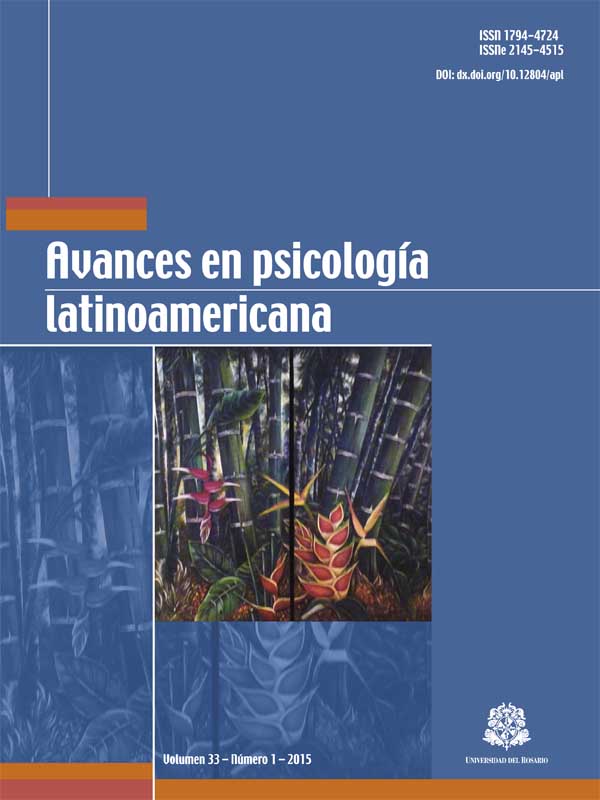Un estudio exploratorio acerca de las fortalezas del carácter en niños argentinos
Barra lateral del artículo
Contenido principal del artículo
Esta investigación se centró en el segundo pilar de la Psicología Positiva ―las virtudes y fortalezas del carácter― con el fin de explorar mediante un enfoque mixto, es decir, émico-ético, las fortalezas autopercibidas en 163 niños, 51 % varones y 49 % mujeres pertenecientes a la Ciudad de Buenos Aires (Argentina). El 40 % de los participantes tenía diez años, el 28 % tenía once años y el 32 % tenía doce años. Se les solicitó a los participantes que describieran con sus palabras las fortalezas del carácter que reconocían en sí mismos. Dentro de las fortalezas más reportadas por los participantes se encontraron la integridad y la bondad. Dentro de las menos reportadas como presentes, se hallaron la espiritualidad, el amor por el conocimiento y la prudencia. Asimismo, se encontraron diferencias en las fortalezas autopercibidas de acuerdo con el sexo y la edad. En las respuestas brindadas por los niños no surgieron fortalezas distintas a las previstas en la clasificación Values in Action.
Descargas
Alarcón, R. (2002). Estudios sobre psicología latinoamericana. Lima, Perú: Universidad Ricardo Palma.
Albuquerque, A. S., & Tróccoli, B. T. (2004). Desenvolvimento de uma escala de bemestar subjetivo. Psicologia: Teoria e Pesquisa, 20, 153-164.
Anderman, E. M. & Young, A. J. (1994). Motivation and strategy use in science: individual differences and classroom effects. Journal of Research in Science Teaching, 31, 811- 831.
Anguas Plata, A. M. (2001). Identificación y validación del significado de bienestar subjetivo en México: Fundamentos para el desarrollo de un instrumento de medición. Interamerican Journal of Psychology, 35, 163- 183.
Ballesteros, B., Medina, A. & Caycedo, C. (2006). El bienestar psicológico definido por asistentes a un servicio de consulta psicológica en Bogotá, Colombia. Universitas Psychologica, 5(2), 239-258.
Berry, J. W. (1969). On cross-cultural comparability. International Journal of Psychology, 4 (2), 119-128.
Berry, J. W., Poortinga, Y. H., Segall, M. H. & Dasen, P. R. (2002). Cross-cultural psychology: research and applications. 2nd edn. New York: Cambridge University Press.
Carr, A. (2007). Psicología positiva: La ciencia de la felicidad. Barcelona: Paidós.
Castro Solano, A. (2012). La psicología positiva en América Latina. Desarrollos y perspectiva. Psiencia Latin American Journal of Psychological Science, 4 (2), 108-116.
Casullo, M. M. & Castro Solano, A. (2000). Evaluación del bienestar psicológico en estudiantes adolescentes argentinos. Revista de Psicología de la Pontificia Universidad Católica de Perú, 18 (2), 36-68.
Cillessen, A. & Rose, A. (2005). Understanding popularity in the peer system. Curr. Dir. Psychol. Sci. 14: 102-105.
Cosentino, A. C. (2011). Fortalezas del carácter en militares argentinos (Tesis Doctoral). Universidad de Palermo, Argentina.
Cosentino, A.C. & Castro Solano, A. (2012). Character Strengths: A Study of Argentinean Soldiers. The Spanish Journal of Psychology, 15 (1), 199-215.
Dahlsgaard, K., Peterson, C. & Seligman, M. (2005). Shared virtue: The convergence of valued human strengths across culture and history. Review of General Psychology, 9, 203-213.
Diener, E. (2006). Guidelinesfor national indicators of subjective well-being and ill-being. Applied Research in Quality of Life,1, 151-157.
Erickson, S.J. & Feldstein, S.W. (2007). Adolescent Humor and its relationship Coing, Defense Strategies, Psychological Distress, and Well Being. Child Psychiatry and Human Development, 37, 255 - 271.
Fowler, R. D., Seligman, M. P., & Koocher, G. P. (1999). The APA 1998 Annual Report. American Psychologist, 54, 537-568.
Froh, J., Sefick, W. & Emmons, R. (2008). Counting blessings in early adolescents. An experimental study of gratitude and subjective well-being. Journal of School Psychology, 46(2), 213- 233.
Gable, S.L. & Haidt, J. (2005). What (and why) is positive psychology? Review of General Psychology, 9, 103-110.
Giménez Hernández, M. (2010). La medida de las fortalezas psicológicas en adolescentes (VIA youth: Relación con clima familiar, psicopatología y bienestar psicológico. (Tesis doctoral). Universidad Complutense de Madrid. Madrid, España.
Kashdan, T.B. & Yuen, M. (2007). Wether highly curious students thrive academically depends on perceptions about the school learning environment: a study of Hong Kong adolescents. Motivation and Emotion, 31, 260 - 270.
Linley, A., Joseph, A., Harrington, S. & Wood, A. (2006). Positive psychology: Past, present and (possible) future. The Journal of Positive Psychology, 1, (1), 3-16.
Marques, S.S., Pais-Ribeiro, J.L. & Lopez, S.J. (2007) Hope in relation to life satisfaction, mental-health, and self-worth in students. Póster presentado en el X Congreso Europeo de Psicología, Praga, República Checa.
Park, N. (2004a). The role of subjective well-being in positive youth development. The Annals of the American Academy of Political and Social Science, 591, 25-39.
Park, N. (2004b). Character strengths and positive youth development. The Annals of the American Academy of Political and Social Science, 591, 40-54.
Park, N. & Peterson, C. (2006). Character Strengths and happiness among young children: Content analysis of parental descriptions. Journal of Happiness Studies, 7, 323-341.
Park, N. & Peterson, C. (2009). Achieving and sustaining a good life. Perspective son Psychological Science, 4, 422-428.
Park, N., Peterson, C., & Seligman, M.E.P. (2006). Character strengths in fifty-four nations and the fifty US states. Journal of Positive Psychology, 1, 118-129.
Peterson, C., & Park, N. (2003). Positive psychology as the evenhanded positive psychologist views it. Psychological Inquiry, 14, 141–146.
Peterson, C., & Seligman, M. E. P. (2004). Character strengths and virtues: A classification and handbook.Washington, DC: American Psychological Association/New York: Oxford University Press.
Peterson, C., Park, N., & Seligman, M. E. P. (2005). Orientations to happiness and life satisfaction: The full life versus the empty life. Journal of Happiness Studies, 6(1), 25- 41.
Piaget, J. (1932). The moral judgment of the child. Translated by M. Worden. New York: Harcourt, Brace, and World.
Richards, M., & Huppert, F.A. (2011). Do positive children become positive adults? Evidence from a longitudinal birth cohort study. Journal of Positive Psychology, 6, 75-87.
Seligman, M. & Csikszentmihalyi, M. (2000). Positive Psychology: An introduction. American Psychologist 55(1), 5-14.
Schwartz, S. (2001). ¿ Existen aspectos universales en la estructura y contenido de los valores humanos? En: M. Ros y V. Gouveia (eds). Psicología Social de los Valores Humanos. Madrid: Biblioteca Nueva. (53-76).
Shimai, S., Otake, K., Park, N., Peterson, C. & Seligman, M.E.P. (2006). Convergence of character strengths in American and Japanese Young Adults. Journal of Happiness Studies, 7, 311-322.
Sinha, D. (1997). Indigenizing psychology. In J. W. Berry, Y. H. Poortinga, & J. Pandey (Eds.), Handbook of cross-cultural psychology: Vol. 1. Theory and method (2nd ed.). Boston: Allyn & Bacon.
Triandis, H., Malpass, R. & Davidson, A. (1973). Psychology and Culture. Annual Review of Psychology, 24, 355-78.
Zimmerman, B. J., Bandura, A., & Martinez-Pons, M. (1992). Self-motivation for academic attainment: The role of self-efficacy beliefs and personal goal setting. American Educational Research Journal, 29, 663 - 676.
Detalles del artículo
Los autores conservan los derechos de autor y garantizan a la revista el derecho de ser la primera publicación del trabajo al igual que licenciado bajo una Creative Commons Attribution License que permite a otros compartir el trabajo con un reconocimiento de la autoría del trabajo y la publicación inicial en esta revista.
Artículos más leídos del mismo autor/a
- Alejandro Castro Solano, Alejandro César Cosentino, IVyF abreviado —IVyFabre—: análisis psicométrico y de estructura factorial en Argentina , Avances en Psicología Latinoamericana : Vol. 36 Núm. 3 (2018): Avances en Psicología Latinoamericana
- María Laura Lupano Perugini, Alejandro Castro Solano, Diseño y validación de un instrumento para evaluar comportamiento contraproducente online , Avances en Psicología Latinoamericana : Vol. 41 Núm. 3 (2023): Avances en Psicología Latinoamericana
- Alejandro César Cosentino, Sergio Héctor Azzara, Aldana Sol Grinhauz, La toma de decisión emocional afecta negativamente la eficacia de la primera ayuda psicológica , Avances en Psicología Latinoamericana : Vol. 41 Núm. 3 (2023): Avances en Psicología Latinoamericana








